|
UNITED STATES |
|
SECURITIES AND EXCHANGE COMMISSION |
|
Washington, D.C. 20549 |
|
|
|
FORM N-CSR |
|
CERTIFIED SHAREHOLDER REPORT OF REGISTERED |
|
MANAGEMENT INVESTMENT COMPANIES |
|
|
|
Investment Company Act File Number: 811-2958 |
|
T. Rowe
Price International Funds, Inc. |
|
(Exact name of registrant as specified in charter) |
|
100 East Pratt Street,
Baltimore, MD 21202 |
|
(Address of
principal executive offices) |
|
David Oestreicher |
|
100 East Pratt Street,
Baltimore, MD 21202 |
|
(Name and
address of agent for service) |
|
Registrant’s telephone number, including area code: (410) 345-2000 |
| Date of fiscal year end: October 31 |
| Date of reporting period: April 30, 2011 |
Item 1: Report to Shareholders
 |
| Emerging Markets Stock Fund | April 30, 2011 |

The views and opinions in this report were current as of April 30, 2011. They are not guarantees of performance or investment results and should not be taken as investment advice. Investment decisions reflect a variety of factors, and the managers reserve the right to change their views about individual stocks, sectors, and the markets at any time. As a result, the views expressed should not be relied upon as a forecast of the fund’s future investment intent. The report is certified under the Sarbanes-Oxley Act, which requires mutual funds and other public companies to affirm that, to the best of their knowledge, the information in their financial reports is fairly and accurately stated in all material respects.
REPORTS ON THE WEB
Sign up for our E-mail Program, and you can begin to receive updated fund reports and prospectuses online rather than through the mail. Log in to your account at troweprice.com for more information.
Manager’s Letter
Fellow Shareholders
Emerging markets gained ground over the last six months but trailed their developed counterparts amid the intensifying challenges of domestic inflation that governments have had mixed results in containing. Developing economies imposed monetary tightening measures during the period to stem price gains, prompting investors to seek higher returns in developed markets equities. In this climate, India suffered a loss, China eked out a paltry gain, and Brazil had a modest return. Nonetheless, a number of emerging markets generated solid gains, and most sectors advanced. Your fund took advantage of growth opportunities in a number of markets and generated a solid gain.
PERFORMANCE REVIEW
In the six-month period ended April 30, 2011, your fund returned 8.06%. As shown in the Performance Comparison table, the fund lagged the MSCI Emerging Markets Index but surpassed the Lipper Emerging Markets Funds Average. Stock selection in India weighed on results due to weakness in the utilities and industrials and business services sectors. Our underweight in South Korea relative to the benchmark also hampered results.

Over the past six months, nearly every sector in the portfolio gained in U.S. dollar terms, with solid returns in energy, information technology, and materials. Energy gained on the surge in oil and gas prices, and our increased allocation to the sector helped results. Information technology continues to be a core holding of the fund and performed well with the help of Internet and semiconductor holdings. Materials, which had lagged the previous period, performed well on the back of improved pricing for mining stocks and the construction industry, particularly in China. Financials, the fund’s largest sector allocation, benefited from commercial bank holdings in Russia and China, though was adversely affected by our allocation to some banks in Turkey, which declined amid political strife in the Middle East and North Africa. Real estate holdings continued to weigh on gains, and we sold some of our shares in Chinese markets. However, we see some exciting opportunities in the housing market, particularly in Brazil, and increased our allocation there.
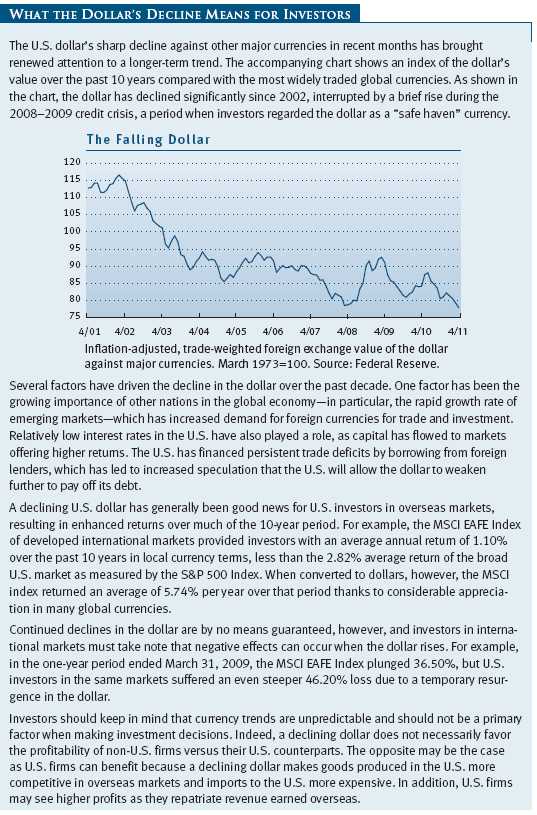
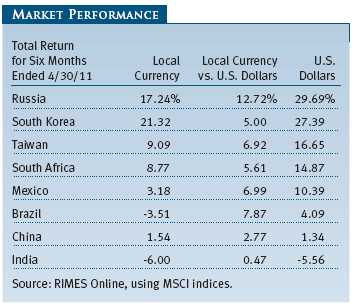
We have small allocations to the utilities and industrials and business services sectors. However, our holdings in India weighed on results. Nonetheless, we believe the infrastructure needs of India are unparalleled and have retained our holdings in this segment of the market. We sold our small remaining allocation to Egypt due to uncertainty about the country’s political stewardship following the political revolution there. Overall, we reduced our allocation to the Middle East and North Africa (MENA) region and added resources in emerging Europe, where we see continued promising growth. Emerging Asia remains the fund’s largest allocation, followed by Latin America.
MARKET AND PORTFOLIO REVIEW
Emerging markets made some headway in curbing inflationary pressures by implementing interest rate hikes and other monetary measures during the period. But the prospect of continuing rate hikes and other factors, including strife in the MENA region and the aftermath of the Japan earthquake, made investors more risk averse and resulted in increased volatility. India declined, China managed only a small gain, and Brazil advanced slightly. While these larger countries struggled, many emerging markets showed impressive resilience. Indeed, emerging markets posted strong gains overall during the period, led by major advances in the emerging Europe, Middle East, and Africa (EMEA) region largely due to the extraordinary performance of Russia, which benefited from the surge in oil prices. Emerging Asia generated a strong gain, as South Korea advanced on export growth and other smaller Asian markets easily outperformed China. Latin America had a small gain due to the continued weakness in Brazil, where the newly elected government imposed more fiscal and monetary restraint. However, higher rates, while beginning to dampen growth, have also had the undesirable effect of luring foreign capital. This has increased the value of the Brazilian real against the flagging U.S. dollar, which has hurt the profitability of the country’s exporters.
Emerging Asia
Emerging Asian markets gained about 10% in dollar terms in the six-month period ended April 30, 2011. We are underweight Asia due to our lower allocations to Taiwan and South Korea, which we believe offer fewer growth opportunities than
the rest of the region over the long term. China remains our largest country allocation, at more than 19% of the portfolio, and while it faltered during the last six months, our stock selection helped relative performance. The country continued to
grapple with inflation, as rising consumer prices have exceeded government targets every month since July 2010, and estimated inflation has risen to 5.0% from 4.7%. China’s gross domestic product (GDP) growth of 9.3% was revised upward from
9.0%, but the rate appears to be within the government’s comfort zone. We have positioned the fund to take advantage of accelerating growth and see increasing opportunities among companies exposed to higher consumer spending.
Our Chinese Internet software and services companies continue to see robust expansion. Online media company Sina and Baidu, the leading Chinese Internet search engine, performed exceptionally well during the period, as did Tencent, the popular free instant messaging service. Among our materials holdings, China National Building and China Shanshui Cement had strong gains as the demand for new bridges, roadways, and dams remains intense. The country’s real estate segment has received considerable attention, as many investors fear a potential housing bubble. However, housing prices have generally risen at the same pace as income growth for the past 10 years, and while signs of froth in prices may be evident in some markets, we continue to see opportunities in this area. During the period, we bought China Vanke, a developer of low-income housing that the country sorely needs. We also own C C Land, which develops properties in western China. (Please refer to the portfolio of investments for a detailed list of holdings and the amount each represents in the portfolio.)
India is grappling with higher inflation due largely to the surge in food prices. We recognize that inflationary pressures, which are increasing demands for wage increases, may not recede for some time. However, these developments have not materially affected our long-term investment thesis of strong growth. Infrastructure and energy needs remain great. We bought shares of Coal India, the world’s largest coal company. Coal provides more than half of India’s energy needs, and demand will likely increase with the country’s power generation capacity. Several industrials holdings performed poorly in a climate of higher interest rates. These include Container Corporation of India, GMR Infrastructure, and Jaiprakash Associates. However, we think the long-term prospects for these companies remain bright. We eliminated our position in business process outsourcing company Genpact due to concerns about weaker earnings results. We also eliminated Bajaj Auto, the second-largest motorcycle maker in India, as valuations are stretched.

We have reduced our holdings in Taiwan and South Korea but continue to own Samsung Electronics, which performed exceedingly well during the period due to strong exports. However, we eliminated Shinsegae, South Korea’s largest discount store company, as it is being split into two businesses, neither of which we think will perform well on its own. We continue to see growth opportunities in Taiwan information technology companies Taiwan Semiconductor and FoxConn Technology.
Europe, Middle East, and Africa
The EMEA region gained nearly 17% in the past six months, fueled by strong growth in Eastern Europe and blistering returns in Russian energy companies. Gazprom and OAO Rosneft Oil were among the portfolio’s largest gainers during the period as oil prices soared. We added to Gazprom, as we believe this state-owned oil and gas company will benefit from further penetration in
Europe and possible increases in gas sales to Asia. However, we are underweight versus the benchmark due to concerns about government controls. Sberbank also performed well. It is a well-capitalized Russian bank benefiting from increased consumer loan demand and strong deposit growth. CTC Media, the largest independent TV broadcaster in Russia, benefited
from the rapid growth of advertising spending.
Turkey sold off on risk aversion due to fears that the upheaval in the Middle East and North Africa could disrupt trade. Nonetheless, we believe the sell-off is temporary and have added to some of our holdings on weakness. During the period, Turkish bank stocks Turkiye Garanti Bankasi and Turkiye Halk Bankasi performed poorly despite an improving economy. Discount retailer BIM Birlesik Magazalar performed well, and we expect positive earnings growth in the periods ahead.
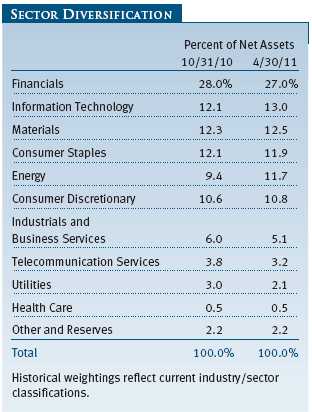
We have maintained an underweight in the MENA region largely because we have only small positions in South Africa, where growth prospects are less robust than in most emerging economies. Gold producer AngloGold Ashanti continued to perform well, as the metals and mining sector benefited from the surge in commodity prices. Truworths, a department store, also performed well. Last period we initiated a large position in Standard Bank Group, the largest bank in South Africa, which should gain market share as it is focused on emerging markets growth. In the United Arab Emirates, we retained our position in DP World, a leading global port operator that is rapidly expanding capacity in a number of new ventures, and sold Aldar Properties, a government-backed developer in Abu Dhabi.
Latin America
Latin American markets gained about 4% in the last six months, as Brazil’s accelerating inflation rate appeared to worry investors. While we believe that the long-term economic prospects are bright with greater consumption levels fed by a burgeoning middle class, we made several adjustments as stocks underperformed their developing market peers. We added to leading
Brazilian retailer Lojas Renner on weakness. The well-run company was hurt by higher cotton prices, but we believe it should see improving margins. We eliminated our position in credit card processing
company Cielo due to increased competition and potentially lower margins. We also added to Itau Unibanco and Banco
Bradesco. Operating trends in Brazil continue to be strong for all banks, and loan growth remains robust. We initiated a position in PDG Realty, a real estate developer focused
on low-income housing. We believe prospects for PDG are considerable, as approximately 60% of the low-cost housing that the company builds is supported in some measure by government subsidies. The company could grow by 20% a year. We also bought
Natura Cosmeticos, a leading cosmetics and fragrance company with 12.9% market share. The company has a strong presence throughout Latin America, and we expect that rising disposable incomes and
consumption growth among women joining the workforce will benefit the company.
Mexico generated a strong performance last period, helped by equity gains in the U.S., its largest trading partner. Walmart de Mexico, the country’s largest retailer, performed well, and we expect it to gain market share through cheaper prices and broader product assortment. Fresnillo, among the world’s largest silver producers, performed exceptionally well due to the surge in prices. While we are mindful that silver prices could retreat, we believe the company remains an attractive holding.
Among other Latin countries, we maintained a small position in Chile, where we own copper miner Antofagasta, which gained on increased global demand. Sociedad Quimica y Minera de Chile, a fertilizer and chemicals producer, also appreciated on increased demand and a capacity expansion program.
OUTLOOK
Emerging markets have produced healthy gains since the market rebound in 2009. We certainly welcome these results and see many encouraging signs of long-term growth. However, we believe near-term challenges could hamper returns. Chief among them is increasing inflation throughout much of the emerging universe. Governments have shown a high level of determination to curtail price gains that is in sharp contrast from previous periods where they were unwilling or unable to arrest inflationary spikes. This change is encouraging, and we believe that further tightening measures may soon run their course in several countries, including China.
Indeed, many markets are poised for continued strong growth. Despite the recent weakness in China, India, and Brazil, we believe these countries are well positioned due to extraordinary growth rates and increasing consumer demand. Likewise, the companies in which we invest have attractive valuations, and we took advantage of recent volatility to increase some existing holdings and to initiate positions of solid companies. We continue to see a number of opportunities in financial companies, which should benefit from loan growth as consumer spending in emerging markets gains traction. We are also excited about the prospects of our holdings in other cyclical sectors that should prosper with growing demand. As the easy market gains were made long ago, we are intensely engaged in identifying companies with strong balance sheets, capable management teams, and realistic plans for gaining market share.
While emerging markets have become less vulnerable to external events than in the past, we are mindful that global connections abound, making no region immune from events occurring in any part of the world. We would remind investors that this fund can be volatile and should represent a small portion of a long-term investor’s well-diversified portfolio.
Respectfully submitted,

Gonzalo Pángaro
Portfolio manager and chairman of the fund’s Investment Advisory Committee
May 16, 2011
The chairman of the fund’s Investment Advisory Committee has day-to-day responsibility for managing the portfolio and works with committee members in developing and executing the fund’s investment program.
RISKS OF INTERNATIONAL INVESTING
Funds that invest overseas generally carry more risk than funds that invest strictly in U.S. assets. Funds investing in a single country or in a limited geographic region tend to be riskier than more-diversified funds. Risks can result from varying stages of economic and political development; differing regulatory environments, trading days, and accounting standards; and higher transaction costs of non-U.S. markets. Non-U.S. investments are also subject to currency risk, or a decline in the value of a foreign currency versus the U.S. dollar, which reduces the dollar value of securities denominated in that currency.
GLOSSARY
Gross domestic product: The total market value of all goods and services produced in a country in a given year.
Lipper averages: The averages of available mutual fund performance returns for specified time periods in defined categories as tracked by Lipper Inc.
MSCI Emerging Markets Index: A capitalization-weighted index of stocks from emerging market countries that only includes securities that may be traded by foreign investors.
Price/earnings (P/E) ratio: A valuation measure calculated by dividing the price of a stock by its reported earnings per share. The ratio is a measure of how much investors are willing to pay for the company’s earnings.
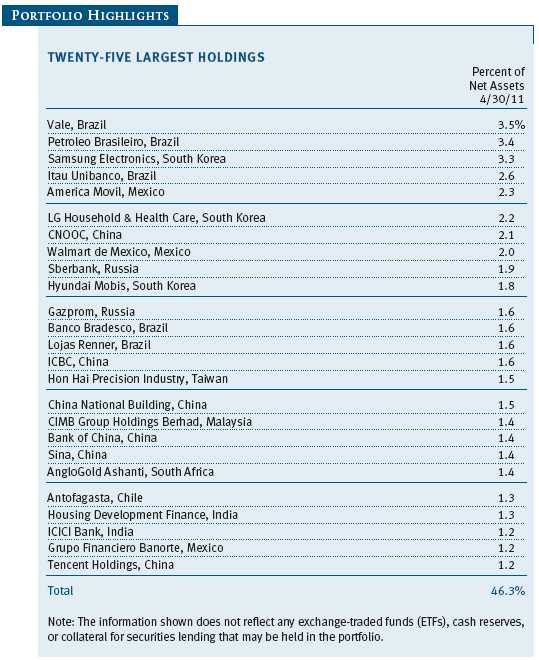
Performance and Expenses
| GROWTH OF $10,000 |
This chart shows the value of a hypothetical $10,000 investment in the fund over the past 10 fiscal year periods or since inception (for funds lacking 10-year records). The result is compared with benchmarks, which may include a broad-based market index and a peer group average or index. Market indexes do not include expenses, which are deducted from fund returns as well as mutual fund averages and indexes.


| FUND EXPENSE EXAMPLE |
As a mutual fund shareholder, you may incur two types of costs: (1) transaction costs, such as redemption fees or sales loads, and (2) ongoing costs, including management fees, distribution and service (12b-1) fees, and other fund expenses. The following example is intended to help you understand your ongoing costs (in dollars) of investing in the fund and to compare these costs with the ongoing costs of investing in other mutual funds. The example is based on an investment of $1,000 invested at the beginning of the most recent six-month period and held for the entire period.
Actual Expenses
The first line of the following table (“Actual”) provides information about actual account values and expenses based on the fund’s actual returns. You may use the information in this line, together with your account
balance, to estimate the expenses that you paid over the period. Simply divide your account value by $1,000 (for example, an $8,600 account value divided by $1,000 = 8.6), then multiply the result by the number in the first line under
the heading “Expenses Paid During Period” to estimate the expenses you paid on your account during this period.
Hypothetical Example for Comparison Purposes
The information on the second line of the table (“Hypothetical”) is based on hypothetical account values and expenses derived from the fund’s actual expense ratio and an assumed 5% per year rate of return before expenses
(not the fund’s actual return). You may compare the ongoing costs of investing in the fund with other funds by contrasting this 5% hypothetical example and the 5% hypothetical examples that appear in the shareholder reports of the other funds.
The hypothetical account values and expenses may not be used to estimate the actual ending account balance or expenses you paid for the period.
Note: T. Rowe Price charges an annual small-account maintenance fee of $10, generally for accounts with less than $2,000 ($500 for UGMA/UTMA). The fee is waived for any investor whose T. Rowe Price mutual fund accounts total $25,000 or more, accounts employing automatic investing, and IRAs and other retirement plan accounts that utilize a prototype plan sponsored by T. Rowe Price (although a separate custodial or administrative fee may apply to such accounts). This fee is not included in the accompanying table. If you are subject to the fee, keep it in mind when you are estimating the ongoing expenses of investing in the fund and when comparing the expenses of this fund with other funds.
You should also be aware that the expenses shown in the table highlight only your ongoing costs and do not reflect any transaction costs, such as redemption fees or sales loads. Therefore, the second line of the table is useful in comparing ongoing costs only and will not help you determine the relative total costs of owning different funds. To the extent a fund charges transaction costs, however, the total cost of owning that fund is higher.
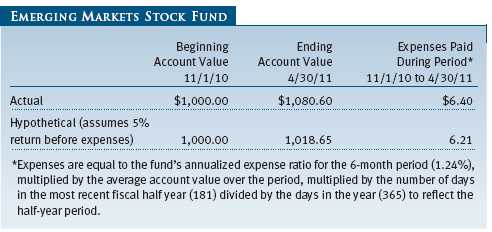
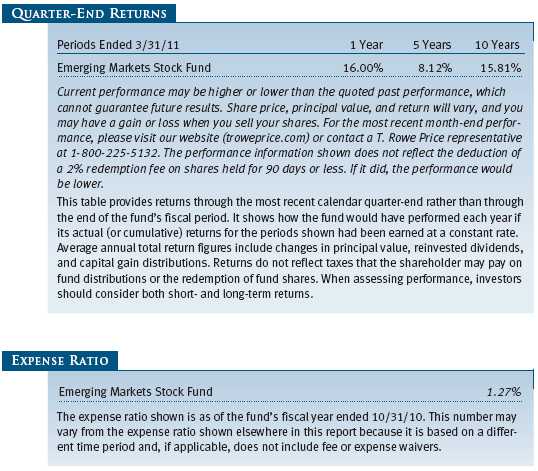
Unaudited
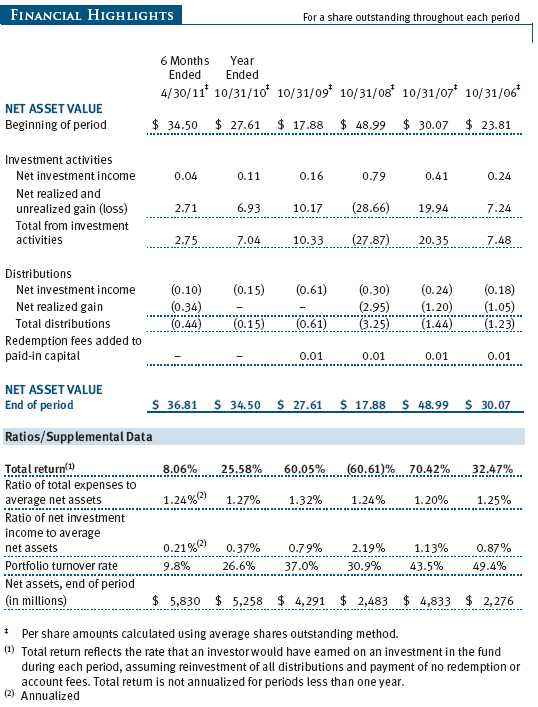
The accompanying notes are an integral part of these financial statements.
Unaudited
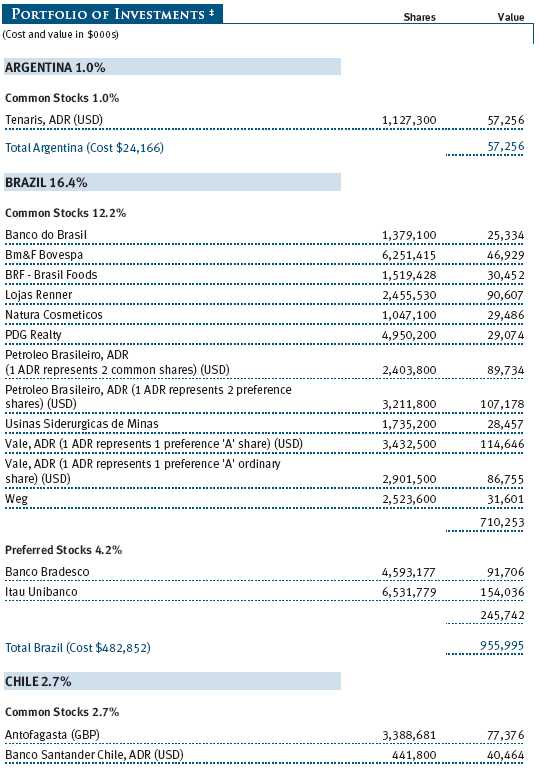
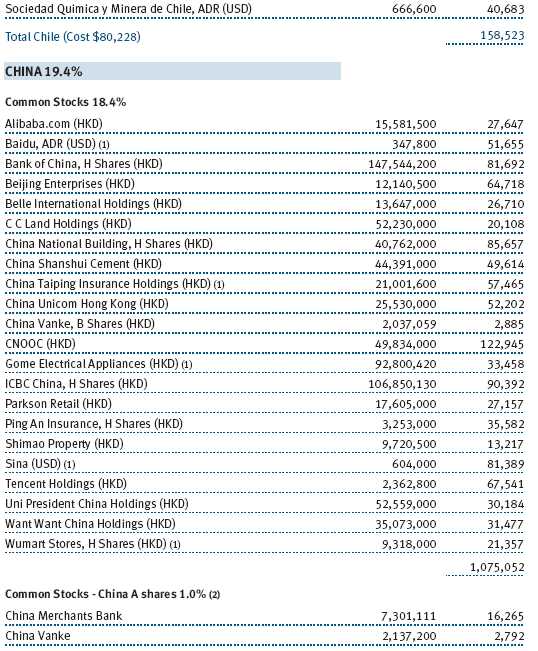
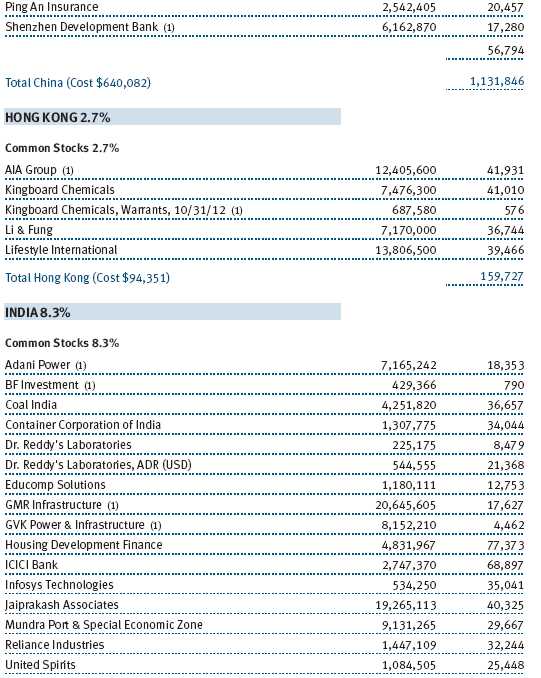

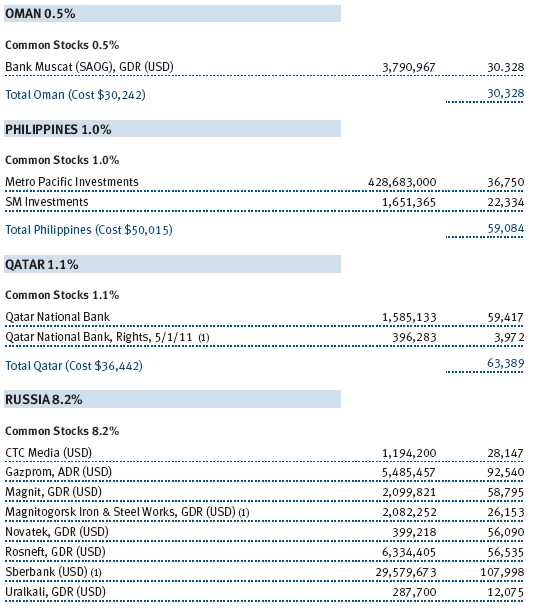

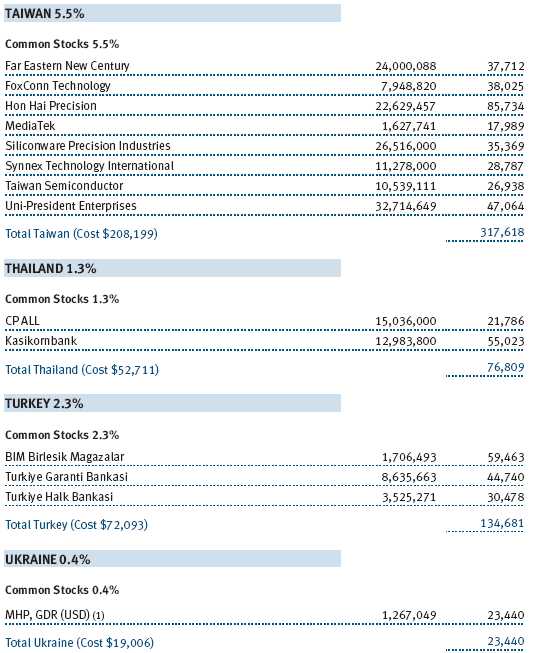


The accompanying notes are an integral part of these financial statements.
Unaudited
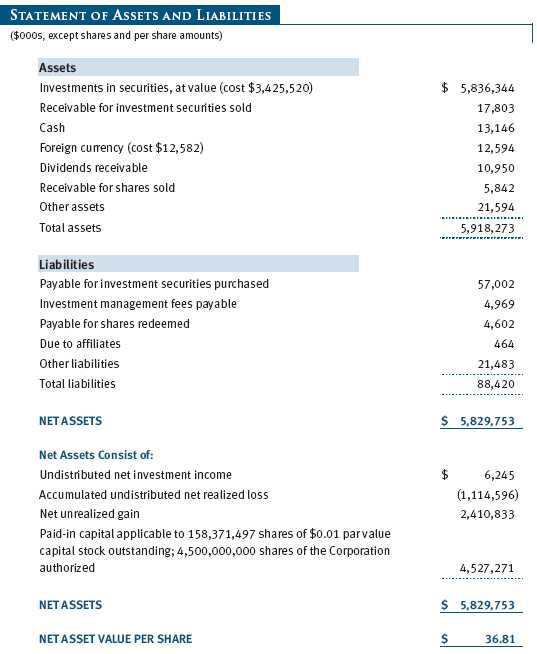
The accompanying notes are an integral part of these financial statements.
Unaudited
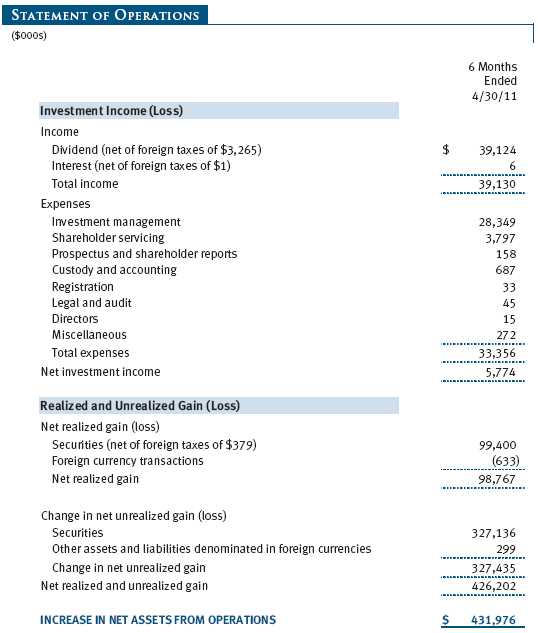
The accompanying notes are an integral part of these financial statements.
Unaudited

The accompanying notes are an integral part of these financial statements.
Unaudited
| NOTES TO FINANCIAL STATEMENTS |
T. Rowe Price International Funds, Inc. (the corporation), is registered under the Investment Company Act of 1940 (the 1940 Act). The Emerging Markets Stock Fund (the fund), a diversified, open-end management investment company, is one portfolio established by the corporation. The fund commenced operations on March 31, 1995. The fund seeks long-term growth of capital through investments primarily in the common stocks of companies located (or with primary operations) in emerging markets.
NOTE 1 - SIGNIFICANT ACCOUNTING POLICIES
Basis of Preparation The accompanying financial statements were prepared in accordance with accounting principles generally accepted in the United States of America (GAAP), which require the use of estimates made by management. Management believes that estimates and valuations are appropriate; however, actual results may differ from those estimates, and the valuations reflected in the accompanying financial statements may differ from the value ultimately realized upon sale or maturity.
Investment Transactions, Investment Income, and Distributions Income and expenses are recorded on the accrual basis. Dividends received from mutual fund investments are reflected as dividend income; capital gain distributions are reflected as realized gain/loss. Dividend income and capital gain distributions are recorded on the ex-dividend date. Income tax-related interest and penalties, if incurred, would be recorded as income tax expense. Investment transactions are accounted for on the trade date. Realized gains and losses are reported on the identified cost basis. Distributions to shareholders are recorded on the ex-dividend date. Income distributions are declared and paid annually. Capital gain distributions, if any, are generally declared and paid by the fund annually.
Currency Translation Assets, including investments, and liabilities denominated in foreign currencies are translated into U.S. dollar values each day at the prevailing exchange rate, using the mean of the bid and asked prices of such currencies against U.S. dollars as quoted by a major bank. Purchases and sales of securities, income, and expenses are translated into U.S. dollars at the prevailing exchange rate on the date of the transaction. The effect of changes in foreign currency exchange rates on realized and unrealized security gains and losses is reflected as a component of security gains and losses.
Credits The fund earns credits on temporarily uninvested cash balances held at the custodian, which reduce the fund’s custody charges. Custody expense in the accompanying financial statements is presented before reduction for credits.
Redemption Fees A 2% fee is assessed on redemptions of fund shares held for 90 days or less to deter short-term trading and to protect the interests of long-term shareholders. Redemption fees are withheld from proceeds that shareholders receive from the sale or exchange of fund shares. The fees are paid to the fund and are recorded as an increase to paid-in capital. The fees may cause the redemption price per share to differ from the net asset value per share.
NOTE 2 - VALUATION
The fund’s financial instruments are reported at fair value as defined by GAAP. The fund determines the values of its assets and liabilities and computes its net asset value per share at the close of the New York Stock Exchange (NYSE), normally 4 p.m. ET, each day that the NYSE is open for business.
Valuation Methods Equity securities listed or regularly traded on a securities exchange or in the over-the-counter (OTC) market are valued at the last quoted sale price or, for certain markets, the official closing price at the time the valuations are made, except for OTC Bulletin Board securities, which are valued at the mean of the latest bid and asked prices. A security that is listed or traded on more than one exchange is valued at the quotation on the exchange determined to be the primary market for such security. Listed securities not traded on a particular day are valued at the mean of the latest bid and asked prices for domestic securities and the last quoted sale price for international securities.
Investments in mutual funds are valued at the mutual fund’s closing net asset value per share on the day of valuation.
Other investments, including restricted securities, and those financial instruments for which the above valuation procedures are inappropriate or are deemed not to reflect fair value are stated at fair value as determined in good faith by the T. Rowe Price Valuation Committee, established by the fund’s Board of Directors.
For valuation purposes, the last quoted prices of non-U.S. equity securities may be adjusted under the circumstances described below. If the fund determines that developments between the close of a foreign market and the close of the NYSE will, in its judgment, materially affect the value of some or all of its portfolio securities, the fund will adjust the previous closing prices to reflect what it believes to be the fair value of the securities as of the close of the NYSE. In deciding whether it is necessary to adjust closing prices to reflect fair value, the fund reviews a variety of factors, including developments in foreign markets, the performance of U.S. securities markets, and the performance of instruments trading in U.S. markets that represent foreign securities and baskets of foreign securities. A fund may also fair value securities in other situations, such as when a particular foreign market is closed but the fund is open. The fund uses outside pricing services to provide it with closing prices and information to evaluate and/or adjust those prices. The fund cannot predict how often it will use closing prices and how often it will determine it necessary to adjust those prices to reflect fair value. As a means of evaluating its security valuation process, the fund routinely compares closing prices, the next day’s opening prices in the same markets, and adjusted prices.
Valuation Inputs Various inputs are used to determine the value of the fund’s financial instruments. These inputs are summarized in the three broad levels listed below:
Level 1 – quoted prices in active markets for identical financial instruments
Level 2 – observable inputs other than Level 1 quoted prices (including, but not limited to, quoted prices for similar financial instruments, interest rates, prepayment speeds, and credit risk)
Level 3 – unobservable inputs
Observable inputs are those based on market data obtained from sources independent of the fund, and unobservable inputs reflect the fund’s own assumptions based on the best information available. The input levels are not necessarily an indication of the risk or liquidity associated with financial instruments at that level. For example, non-U.S. equity securities actively traded in foreign markets generally are reflected in Level 2 despite the availability of closing prices because the fund evaluates and determines whether those closing prices reflect fair value at the close of the NYSE or require adjustment, as described above. The following table summarizes the fund’s financial instruments, based on the inputs used to determine their values on April 30, 2011:
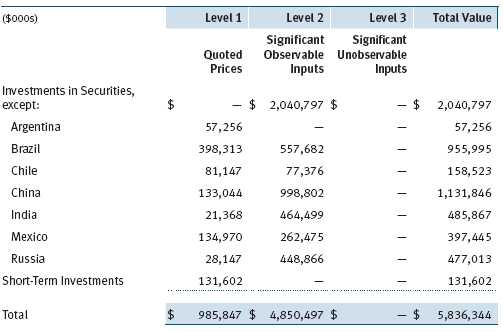
NOTE 3 - OTHER INVESTMENT TRANSACTIONS
Consistent with its investment objective, the fund engages in the following practices to manage exposure to certain risks and/or to enhance performance. The investment objective, policies, program, and risk factors of the fund are described more fully in the fund’s prospectus and Statement of Additional Information.
Emerging Markets At April 30, 2011, approximately 94% of the fund’s net assets were invested, either directly or through investments in T. Rowe Price institutional funds, in securities of companies located in emerging markets, securities issued by governments of emerging market countries, and/or securities denominated in or linked to the currencies of emerging market countries. Emerging market securities are often subject to greater price volatility, less liquidity, and higher rates of inflation than U.S. securities. In addition, emerging markets may be subject to greater political, economic and social uncertainty, and differing regulatory environments that may potentially impact the fund’s ability to buy or sell certain securities or repatriate proceeds to U.S. dollars.
China A shares During the six months ended April 30, 2011, the fund invested in certain Chinese equity securities (A shares) available only to local Chinese investors and Qualified Foreign Institutional Investors (QFII). The fund gains access to the A-share market through a wholly owned subsidiary of T. Rowe Price Group, Inc., which serves as the registered QFII for all participating T. Rowe Price-sponsored products (each a participating account). Investment decisions related to A shares are specific to each participating account, and each account bears the resultant economic and tax consequences of its holdings and transactions in A shares. The fund is subject to certain restrictions and administrative processes relating to its ability to repatriate cash balances, investment proceeds, and earnings associated with its A shares and may incur substantial delays in gaining access to its assets or a loss of value in the event of noncompliance with applicable Chinese rules or requirements. Current Chinese tax law is unclear whether capital gains realized on the fund’s investments in A shares will be subject to tax. Because management believes it more likely than not that Chinese capital gains tax ultimately will not be imposed, there are no accrued taxes reflected in the accompanying financial statements.
Other Purchases and sales of portfolio securities other than short-term securities aggregated $659,560,000 and $519,887,000, respectively, for the six months ended April 30, 2011.
NOTE 4 - FEDERAL INCOME TAXES
No provision for federal income taxes is required since the fund intends to continue to qualify as a regulated investment company under Subchapter M of the Internal Revenue Code and distribute to shareholders all of its taxable income and gains. Distributions determined in accordance with federal income tax regulations may differ in amount or character from net investment income and realized gains for financial reporting purposes. Financial reporting records are adjusted for permanent book/tax differences to reflect tax character but are not adjusted for temporary differences. The amount and character of tax-basis distributions and composition of net assets are finalized at fiscal year-end; accordingly, tax-basis balances have not been determined as of the date of this report.
The fund intends to retain realized gains to the extent of available capital loss carryforwards. As of October 31, 2010, the fund had $1,089,802,000 of unused capital loss carryforwards, which expire: $73,627,000 in fiscal 2016, $1,010,968,000 in fiscal 2017 and $5,207,000 in fiscal 2018.
At April 30, 2011, the cost of investments for federal income tax purposes was $3,425,520,000. Net unrealized gain aggregated $2,410,833,000 at period-end, of which $2,456,061,000 related to appreciated investments and $45,228,000 related to depreciated investments.
NOTE 5 - FOREIGN TAXES
The fund is subject to foreign income taxes imposed by certain countries in which it invests. Acquisition of certain foreign currencies related to security transactions are also subject to tax. Additionally, capital gains realized by the fund upon disposition of securities issued in or by certain foreign countries are subject to capital gains tax imposed by those countries. All taxes are computed in accordance with the applicable foreign tax law, and, to the extent permitted, capital losses are used to offset capital gains. Taxes attributable to income are accrued by the fund as a reduction of income. Taxes incurred on the purchase of foreign currencies are recorded as realized loss on foreign currency transactions. Current and deferred tax expense attributable to net capital gains is reflected as a component of realized and/or change in unrealized gain/loss on securities in the accompanying financial statements. At April 30, 2011, the fund had no deferred tax liability attributable to foreign securities and no foreign capital loss carryforwards.
NOTE 6 - RELATED PARTY TRANSACTIONS
The fund is managed by T. Rowe Price Associates, Inc. (Price Associates), a wholly owned subsidiary of T. Rowe Price Group, Inc. (Price Group). Price Associates has entered into a subadvisory agreement with T. Rowe Price International Ltd a wholly owned subsidiary of Price Associates, to provide investment advisory services to the fund; the subadvisory agreement provides that Price Associates may pay the subadvisor up to 60% of the management fee that Price Associates receives from the fund. The fund was previously managed by T. Rowe Price International, Inc. (Price International), which was merged into its parent company, Price Associates, effective at the close of business on December 31, 2010. Thereafter, Price Associates assumed responsibility for all of Price International’s existing investment management contracts, and Price International ceased all further operations. The corporate reorganization was designed to simplify Price Group’s corporate structure related to its international business and was intended to result in no material changes in the nature, quality, level, or cost of services provided to the T. Rowe Price funds.
The investment management agreement between the fund and Price Associates provides for an annual investment management fee, which is computed daily and paid monthly. The fee consists of an individual fund fee, equal to 0.75% of the fund’s average daily net assets, and a group fee. The group fee rate is calculated based on the combined net assets of certain mutual funds sponsored by Price Associates (the group) applied to a graduated fee schedule, with rates ranging from 0.48% for the first $1 billion of assets to 0.285% for assets in excess of $220 billion. The fund’s group fee is determined by applying the group fee rate to the fund’s average daily net assets. At April 30, 2011, the effective annual group fee rate was 0.30%.
In addition, the fund has entered into service agreements with Price Associates and two wholly owned subsidiaries of Price Associates (collectively, Price). Price Associates computes the daily share price and provides certain other administrative services to the fund. T. Rowe Price Services, Inc., provides shareholder and administrative services in its capacity as the fund’s transfer and dividend disbursing agent. T. Rowe Price Retirement Plan Services, Inc., provides subaccounting and recordkeeping services for certain retirement accounts invested in the fund. For the six months ended April 30, 2011, expenses incurred pursuant to these service agreements were $93,000 for Price Associates; $852,000 for T. Rowe Price Services, Inc.; and $180,000 for T. Rowe Price Retirement Plan Services, Inc. The total amount payable at period-end pursuant to these service agreements is reflected as Due to Affiliates in the accompanying financial statements.
Additionally, the fund is one of several mutual funds in which certain college savings plans managed by Price Associates may invest. As approved by the fund’s Board of Directors, shareholder servicing costs associated with each college savings plan are borne by the fund in proportion to the average daily value of its shares owned by the college savings plan. For the six months ended April 30, 2011, the fund was charged $59,000 for shareholder servicing costs related to the college savings plans, of which $48,000 was for services provided by Price. The amount payable at period-end pursuant to this agreement is reflected as Due to Affiliates in the accompanying financial statements. At April 30, 2011, approximately 1% of the outstanding shares of the fund were held by college savings plans.
The fund is also one of several mutual funds sponsored by Price Associates (underlying Price funds) in which the T. Rowe Price Spectrum Funds (Spectrum Funds) and T. Rowe Price Retirement Funds (Retirement Funds) may invest. Neither the Spectrum Funds nor the Retirement Funds invest in the underlying Price funds for the purpose of exercising management or control. Pursuant to separate special servicing agreements, expenses associated with the operation of the Spectrum and Retirement Funds are borne by each underlying Price fund to the extent of estimated savings to it and in proportion to the average daily value of its shares owned by the Spectrum and Retirement Funds, respectively. Expenses allocated under these agreements are reflected as shareholder servicing expenses in the accompanying financial statements. For the six months ended April 30, 2011, the fund was allocated $101,000 of Spectrum Funds’ expenses and $1,348,000 of Retirement Funds’ expenses. Of these amounts, $841,000 related to services provided by Price. The amount payable at period-end pursuant to this agreement is reflected as Due to Affiliates in the accompanying financial statements. Additionally, redemption fees received by the Spectrum Funds are allocated to each underlying Price fund in proportion to the average daily value of its shares owned by the Spectrum Funds. $1,000 of redemption fees reflected in the accompanying financial statements were received from the Spectrum Funds. At April 30, 2011, approximately 3% of the outstanding shares of the fund were held by the Spectrum Funds and 28% were held by the Retirement Funds.
The fund may invest in the T. Rowe Price Reserve Investment Fund and the T. Rowe Price Government Reserve Investment Fund (collectively, the T. Rowe Price Reserve Investment Funds), open-end management investment companies managed by Price Associates and considered affiliates of the fund. The T. Rowe Price Reserve Investment Funds are offered as cash management options to mutual funds, trusts, and other accounts managed by Price Associates and/or its affiliates and are not available for direct purchase by members of the public. The T. Rowe Price Reserve Investment Funds pay no investment management fees.
As of April 30, 2011, T. Rowe Price Group, Inc., and/or its wholly owned subsidiaries owned 92,776 shares of the fund, representing less than 1% of the fund’s net assets.
| INFORMATION ON PROXY VOTING POLICIES, PROCEDURES, AND RECORDS |
A description of the policies and procedures used by T. Rowe Price funds and portfolios to determine how to vote proxies relating to portfolio securities is available in each fund’s Statement of Additional Information, which you may request by calling 1-800-225-5132 or by accessing the SEC’s website, sec.gov. The description of our proxy voting policies and procedures is also available on our website, troweprice.com. To access it, click on the words “Our Company” at the top of our corporate homepage. Then, when the next page appears, click on the words “Proxy Voting Policies” on the left side of the page.
Each fund’s most recent annual proxy voting record is available on our website and through the SEC’s website. To access it through our website, follow the directions above, then click on the words “Proxy Voting
Records” on the right side of the Proxy Voting Policies page.
| HOW TO OBTAIN QUARTERLY PORTFOLIO HOLDINGS |
The fund files a complete schedule of portfolio holdings with the Securities and Exchange Commission for the first and third quarters of each fiscal year on Form N-Q. The fund’s Form N-Q is available electronically on the
SEC’s website (sec.gov); hard copies may be reviewed and copied at the SEC’s Public Reference Room, 450 Fifth St. N.W., Washington, DC 20549. For more information on the Public Reference Room, call 1-800-SEC-0330.
| APPROVAL OF INVESTMENT MANAGEMENT AGREEMENT |
On March 9, 2011, the fund’s Board of Directors (Board) unanimously approved the continuation of the investment advisory contract (Contract) between the fund and its investment advisor, T. Rowe Price Associates, Inc. (Advisor), as well as the investment subadvisory contract (Subadvisory Contract) that the Advisor has entered into with T. Rowe Price International Ltd (Subadvisor). The Board considered a variety of factors in connection with its review of the Contract and Subadvisory Contract, also taking into account information provided by the Advisor during the course of the year, as discussed below:
Services Provided by the Advisor
The Board considered the nature, quality, and extent of the services provided to the fund by the Advisor and Subadvisor. These services included, but were not limited to, management of the fund’s portfolio and a variety of related
activities, as well as financial and administrative services, reporting, and communications. The Board also reviewed the background and experience of the Advisor’s and Subadvisor’s senior management teams and investment personnel involved
in the management of the fund. The Board noted that a restructuring involving the Advisor and certain of its affiliated investment advisors led to a restatement of the fund’s investment advisory contract and a new investment subadvisory
contract, effective at the close of business on December 31, 2010. This restructuring, which resulted in T. Rowe Price Associates, Inc., becoming the fund’s new investment advisor and T. Rowe Price International Ltd becoming the fund’s new
investment subadvisor, had been determined by the Board at a meeting in October 2010 not to diminish the nature, quality, or level of services provided to the fund or materially to change the manner in which advisory services were to be provided.
The Board concluded that it was satisfied with the nature, quality, and extent of the services provided by the Advisor and Subadvisor.
Investment Performance of the Fund
The Board reviewed the fund’s average annual total returns over the 1-, 3-, 5-, and 10-year periods, as well as the fund’s year-by-year returns, and compared these returns with a wide variety of previously agreed upon
comparable performance measures and market data, including those supplied by Lipper and Morningstar, which are independent providers of mutual fund data. On the basis of this evaluation and the Board’s ongoing review of investment results, and
factoring in the relative market conditions during certain of the performance periods, the Board concluded that the fund’s performance was satisfactory.
Costs, Benefits, Profits, and Economies of Scale
The Board reviewed detailed information regarding the revenues received by the Advisor under the Contract and other benefits that the Advisor (and its affiliates, including the Subadvisor) may have realized from its relationship with
the fund, including research received under “soft dollar” agreements and commission-sharing arrangements with broker-dealers. The Board considered that the Advisor and Subadvisor may receive some benefit from soft-dollar arrangements
pursuant to which research is received from broker-dealers that execute the applicable fund’s portfolio transactions. The Board also received information on the estimated costs incurred and profits realized by the Advisor and its affiliates (including the Subadvisor) from advising T. Rowe Price mutual funds, as well as estimates of the gross profits realized from managing the fund in particular. The Board concluded that the Advisor’s profits were reasonable in light
of the services provided to the fund. The Board also considered whether the fund or other funds benefit under the fee levels set forth in the Contract from any economies of scale realized by the Advisor. Under the Contract, the fund pays a fee to
the Advisor composed of two components—a group fee rate based on the aggregate assets of certain T. Rowe Price mutual funds (including the fund) that declines at certain asset levels and an individual fund fee rate that is assessed on the
assets of the fund. The Board determined that it would be appropriate to introduce another breakpoint into the group fee rate, effective May 1, 2011, to allow fund shareholders to participate in additional economies of scale. Under the Subadvisory
Contract, the Advisor may pay the Subadvisor up to 60% of the advisory fee that the Advisor receives from the fund. The Board concluded that the advisory fee structure for the fund continued to provide for a reasonable sharing of benefits from any
economies of scale with the fund’s investors.
Fees
The Board reviewed the fund’s management fee rate, operating expenses, and total expense ratio and compared them with fees and expenses of other comparable funds based on information and data supplied by Lipper. The information
provided to the Board indicated that the fund’s management fee rate was above the median for certain groups of comparable funds but at or below the median for other groups of comparable funds. The information also indicated that the fund’s
total expense ratio was below the median for comparable funds. The Board also reviewed the fee schedules for institutional accounts of the Advisor and its affiliates with similar mandates. Management provided the Board with information about the
Advisor’s responsibilities and services provided to institutional account clients, which are more limited than its responsibilities for the fund and other T. Rowe Price mutual funds that it advises, and showing that the Advisor performs
significant additional services and assumes greater risk for the fund and other T. Rowe Price mutual funds that it advises than it does for institutional account clients. On the basis of the information provided, the Board concluded that the fees
paid by the fund under the Contract were reasonable.
Approval of the Contract
As noted, the Board approved the continuation of the Contract and Subadvisory Contract (and the inclusion of an additional breakpoint in the group fee schedule). No single factor was considered in isolation or to be determinative to the
decision. Rather, the Board was assisted by the advice of independent legal counsel and concluded, in light of a weighting and balancing of all factors considered, that it was in the best interests of the fund to approve the continuation of the
Contract and the Subadvisory Contract (including the fees to be charged for services thereunder).
Item 2. Code of Ethics.
A code of ethics, as defined in Item 2 of Form N-CSR, applicable to its principal executive officer, principal financial officer, principal accounting officer or controller, or persons performing similar functions is filed as an exhibit to the registrant’s annual Form N-CSR. No substantive amendments were approved or waivers were granted to this code of ethics during the registrant’s most recent fiscal half-year.
Item 3. Audit Committee Financial Expert.
Disclosure required in registrant’s annual Form N-CSR.
Item 4. Principal Accountant Fees and Services.
Disclosure required in registrant’s annual Form N-CSR.
Item 5. Audit Committee of Listed Registrants.
Not applicable.
Item 6. Investments.
(a) Not applicable. The complete schedule of investments is included in Item 1 of this Form N-CSR.
(b) Not applicable.
Item 7. Disclosure of Proxy Voting Policies and Procedures for Closed-End Management Investment Companies.
Not applicable.
Item 8. Portfolio Managers of Closed-End Management Investment Companies.
Not applicable.
Item 9. Purchases of Equity Securities by Closed-End Management Investment Company and Affiliated Purchasers.
Not applicable.
Item 10. Submission of Matters to a Vote of Security Holders.
Not applicable.
Item 11. Controls and Procedures.
(a) The registrant’s principal executive officer and principal financial officer have evaluated the registrant’s disclosure controls and procedures within 90 days of this filing and have concluded that the registrant’s disclosure controls and procedures were effective, as of that date, in ensuring that information required to be disclosed by the registrant in this Form N-CSR was recorded, processed, summarized, and reported timely.
(b) The registrant’s principal executive officer and principal financial officer are aware of no change in the registrant’s internal control over financial reporting that occurred during the registrant’s second fiscal quarter covered by this report that has materially affected, or is reasonably likely to materially affect, the registrant’s internal control over financial reporting.
Item 12. Exhibits.
(a)(1) The registrant’s code of ethics pursuant to Item 2 of Form N-CSR is filed with the registrant’s annual Form N-CSR.
(2) Separate certifications by the registrant's principal executive officer and principal financial officer, pursuant to Section 302 of the Sarbanes-Oxley Act of 2002 and required by Rule 30a-2(a) under the Investment Company Act of 1940, are attached.
(3) Written solicitation to repurchase securities issued by closed-end companies: not applicable.
(b) A certification by the registrant's principal executive officer and principal financial officer, pursuant to Section 906 of the Sarbanes-Oxley Act of 2002 and required by Rule 30a-2(b) under the Investment Company Act of 1940, is attached.
SIGNATURES |
|
| Pursuant to the requirements of the Securities Exchange Act of 1934 and the Investment | |
| Company Act of 1940, the registrant has duly caused this report to be signed on its behalf by the | |
| undersigned, thereunto duly authorized. | |
| T. Rowe Price International Funds, Inc. | |
| By | /s/ Edward C. Bernard |
| Edward C. Bernard | |
| Principal Executive Officer | |
| Date | June 16, 2011 |
| Pursuant to the requirements of the Securities Exchange Act of 1934 and the Investment | |
| Company Act of 1940, this report has been signed below by the following persons on behalf of | |
| the registrant and in the capacities and on the dates indicated. | |
| By | /s/ Edward C. Bernard |
| Edward C. Bernard | |
| Principal Executive Officer | |
| Date | June 16, 2011 |
| By | /s/ Gregory K. Hinkle |
| Gregory K. Hinkle | |
| Principal Financial Officer | |
| Date | June 16, 2011 |